MXA RACE TEST: THE REAL TEST OF THE 2025 KTM 450SXF
 THE GEAR: Jersey: Thor MX Prime, Pants: Thor MX Prime, Helmet: Shoei VFX-EVO, Goggles: Viral Brand Signature series, Boots: Alpinestars Tech 10 Supervented.
THE GEAR: Jersey: Thor MX Prime, Pants: Thor MX Prime, Helmet: Shoei VFX-EVO, Goggles: Viral Brand Signature series, Boots: Alpinestars Tech 10 Supervented.
Q: FIRST AND FOREMOST, IS THE 2025 KTM 450SXF BETTER THAN THE 2024 450SXF?
A: Yes. We don’t know how the 2024 KTM 450SXF frame got so rigid. The product managers must have had a target audience in mind, but on what planet did they find riders who were willing to wait 10 hours before the chassis had a semblance of rideability? But, as it is often said, you learn just as much from your mistakes as you do from your successes. The good news is that rider complaints from as high up as their factory riders to as far down as their paying customers sounded the alarm. Their message was, “Fix the frame’s rigidity.” And for 2025, the engineers did.
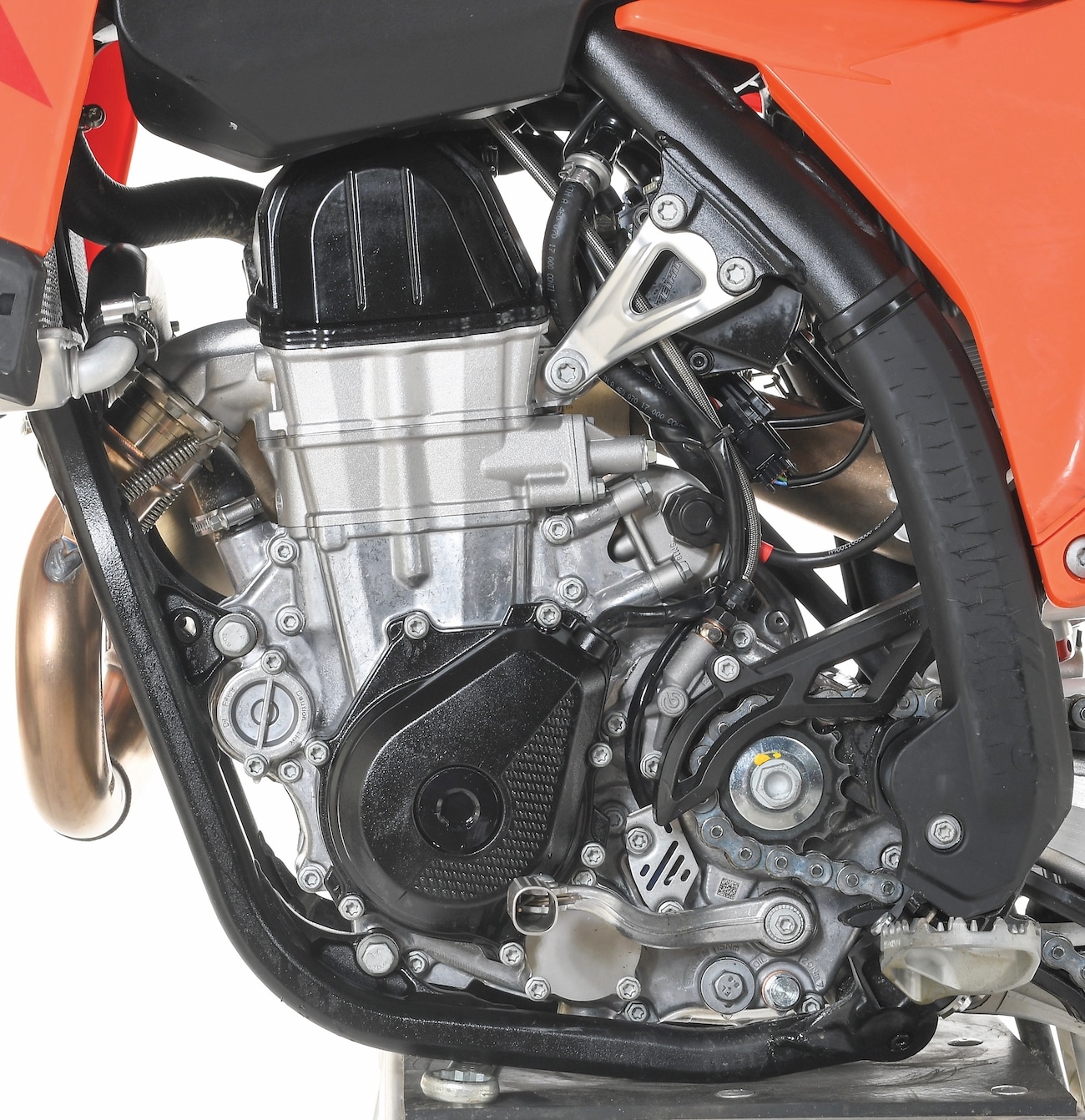 The 2025 KTM 450SXF engine is a 60-horsepower powerplant with a broad, linear and ultra-manageable powerband.
The 2025 KTM 450SXF engine is a 60-horsepower powerplant with a broad, linear and ultra-manageable powerband.
Q: WHY IS IT SO UNIQUE THAT KTM FIXED ITS 2025 CHASSIS?
A: The first thing that comes to mind is that the 2023–2024 KTM chassis was only two years old. A manufacturer needs their major components to have long lifespans in order to get a return on the investment—given the massive costs of redesigning major components. It’s no secret that the “Big Four” Japanese brands work on four-year development schedules. If a new model is released in 2020, it will not get a significant change until 2024. In KTM’s case, they reacted in two years with some serious frame, swingarm, linkage and bodywork updates.
KTM didn’t have to do anything about their engine because it was a 60-horsepower powerplant with a broad, linear and ultra-manageable powerband. Any updates it needed could be done with ancillary components like ECU maps, a reconfigured Quickshift, throttle body and minor reliability tweaks. No manufacturer wants to make major change to their powerplant—unless the market place deems it untenable. And even then, the corporate pencil pushers will point out that it will costs 10 million dollars to test, design and build a new engine.
Think about it: Yamaha decided to keep building two-strokes in large part because their 2006 machines had stout engines and creative plug-and-play frames. They gambled that the major components of the 2006 YZ125 and YZ250 would hold their value, especially since they wouldn’t face any competition from Suzuki, Kawasaki or Honda two-strokes (and back in 2006, they weren’t concerned with what KTM might do).
Even more telling is Suzuki’s reluctance to put electric starters on their two remaining motocross models. They don’t want to do it, because electric starting would require all-new engine cases, electronics, batteries and gear combinations to connect the starter motor of the flywheel—and once they redesigned the cases, it would be foolish not to update the rest of the engine to finger followers, offset cranks, and a new layout. They looked at the upfront costs of a new RM-Z450 engine and most likely decided that they could use those millions to get a running start on developing an all-electric 2027 bike.
On the other hand, Yamaha totally updated the YZ450F in 2023. Kawasaki introduced a new KX450 in 2024, and Honda has a new CRF450 for 2025.
As a rule, the Austrians do not live by the industry-standard, four-year production cycle like the Japanese brands. Historically, KTM makes changes in a much shorter cycle and almost always when issues arise that demand their attention. But, their engines often remain the same for as many as six or more years. A new frame in 2023 and a total revision of it in 2025 would be out of the question in Hamamatsu, but KTM doesn’t make oil tankers, automobiles, pianos, lawnmowers or marine engines. They make motorcycles, and mostly off-road motorcycles. That is what brought them to the party.
 The 2025 KTM 450SXF is a clean machine. The black frame, triple clamps, rims, valve cover, muffler and ignition cover make the sleeker orange plastic really pop.
The 2025 KTM 450SXF is a clean machine. The black frame, triple clamps, rims, valve cover, muffler and ignition cover make the sleeker orange plastic really pop.
Q: WHAT’S NEW ON THE 2025 KTM 450SXF CHASSIS?
A: First of all, there are two distinct KTM frames as of late. The first one was released in 2023 and was highlighted by an increase in stiffness—theoretically to appeal more to pro riders. They made a lot of changes to the 2022 frame to make it stiffer. Need a list?
(1) Forged plates on top of the frame’s backbone, with similar plates on the downtube.
(2) A new forged shock tower that separated the rear suspension loads from the head tube of the frame.
(3) Two symmetrical frame tubes that ran from the shock tower down to the footpeg gussets on both sides of the bike.
(4) Forged motor mounts welded to that frame that ensured that the engine was a stressed member of the frame.
(5) Thick, triangular head stays that locked the engine in place.
The second frame was introduced on the 2024-1/2 KTM 450SXF Factory Edition and is the 2025 KTM frame. It focused on undoing the five stiffness-producing updates on the 2023 frame. The goal was to build a more resilient chassis that absorbed more energy, cut down on kickback and didn’t require 10 hours of break-in time. Here is what the KTM engineers did for 2025.
(1) The stiff, triangulated shock tower had relief holes cut into both sides of the shock tower. The goal was to make the central point of the chassis more flexible.
(2) To stiffen the head tube area on the 2023–2024 KTM 450SXF, thick, forged steel plates were welded to the top of the frame’s backbone; they wrapped around the steering head and were joined by another forged plate below the head tube. For 2025, the forged plates remained (because they increase the strength of the head tube area), but the thickness of the plates was reduced to give them more resilience.
(3) The two symmetrical frame tubes that ran from the shock tower down to the footpeg bracket got thinner wall thicknesses to put more spring into the chassis, both longitudinally and torsionally.
(4) Head stays are one of the most commonly changed frame components. These triangle-shaped plates are attached to the frame with two bolts and connected to the cylinder head to help bind the chassis together with the structural mass of the engine. On the 2025 KTM 450SXF, the head stays have CNC-machined openings designed to soften up the feel and improve front and rear bite.
(5) Starting in 2023, KTM tilted the engine 2 degrees rearward and moved it down 3mm to lessen the 2022-and-earlier KTM’s tendency to squat under hard acceleration. This is unchanged for 2025, because the anti-chain torque pluses made the chassis better in consecutive whoops, rutted corners and any time the throttle was held wide open; however, lowering the countershaft sprocket meant that the chain line had to angle downward at a steep angle to get the chain to the countershaft sprocket. The result was that the chain would eat through the swingarm’s buffer pad and eventually through the aluminum swingarm. For 2025, KTM shaved the top of the swingarm down to make it lower, while the thickness of the buffer pad on top of the swingarm has been increased to keep the chain from wearing through.
(6) They didn’t do anything to the forged engine mounts, because that would have required separate steel or aluminum plates to attach the engine to the frame. They left this area alone because they had cast the 2023 engine cases to mate perfectly up to the engine mounts.
 KTM didn’t chase aggressive turn-in for 2025 because they didn’t need to, their chasssis is stable, accurate and not prone to oversteer or head stake. It’s all good.
KTM didn’t chase aggressive turn-in for 2025 because they didn’t need to, their chasssis is stable, accurate and not prone to oversteer or head stake. It’s all good.
Q: WHAT DO ALL OF THESE FRAME CHANGES ACHIEVE?
A: A vast improvement in feel and comfort, improved chassis response, and mesmerizing controllability. The 2025 frame is more resilient in the first couple rides and feels better than the 10-hour 2024 frame immediately. How much time and testing you put into your suspension can make the frame feel better or worse, but as it sits it feels very compliant.
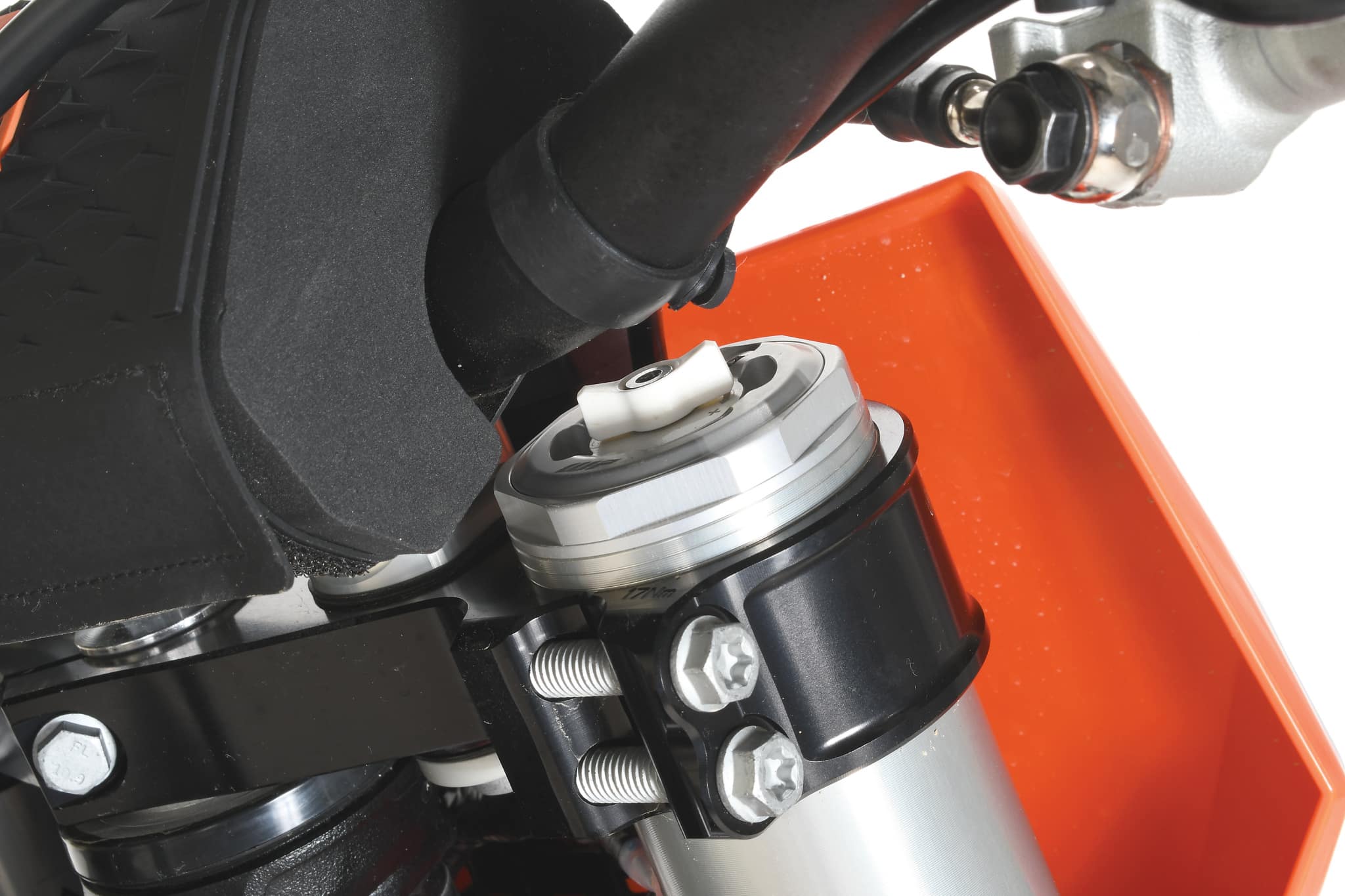 All of the damping adjusters on the WP suspension components can be turned by hand.
All of the damping adjusters on the WP suspension components can be turned by hand.
Q: WHAT’S NEW ON THE 2025 KTM 450SXF SUSPENSION?
A: Forks: If you’ve never ridden with WP air forks from 2021 on up to 2025, you aren’t up to date on how they work. Starting in 2021, WP implemented a series of technical innovations to address most of the previous air fork issues on WP, Showa and Kayaba air forks. If you have never lived with or raced 2021 and newer WP air forks, most of your complaints are outdated. WP instituted five innovative changes in 2021 and has been revising the forks with each model year. They start with oil-bypass notches that reduce oil pressure spikes when the stanchion bushing and cartridge bushings get close together.
There are also new air seals that lessen air-pressure peaks to resist the dreaded J-curve air-pressure spike at the end of the stroke. In 2023, WP came out with the Hydrostop bottoming control system that uses tapered cone shapes to create an “oil lock” that stops the forks from bottoming. Perhaps the best feature of the WP XACT air forks is the trampoline shim. It’s called a “trampoline shim” because it flexes under oil pressure, much like a trampoline goes up and down under a gymnast’s body weight. The trampoline valve lessens the mid-stroke spike when the shim stack is over-pressurized. If you look closely at the fork cap on the left leg, you will notice a black anodized threaded plug. Do not remove it. It has nothing to do with the forks on the 2025 KTM 450SXF. It is where a data-acquisition sensor will plug into the forks in the future.
The biggest rear suspension change for 2025 revolves around the shock linkage. The linkage arms were 16.2mm tall on the 2024 model; for 2025, they are 13.6mm tall and 2mm thinner. The shock bolt that attached to the linkage’s bell crank is downsized from 17mm to 15mm, while the bolt on the other end of the bell crank is reduced from 17mm to 14mm. Even the ribbing on the flat sides of the bell crank, which was 6.3mm, is now 5.3mm deep.
Why all the downsizing of the link arms, bell crank and bolts? KTM discovered in testing that the 2023–2024 linkage parts were too rigid. The smaller linkage bolts and slimmer linkage arms not only reduce friction but work in conjunction with the previously updated smaller rear axle to provide more feedback from the rear wheel and get the flex back where KTM wanted it. The 2025 production shock linkage is based on the works linkages.
 Behind the number plate, strapped to the right fork leg, is the new CUO. This allows you to connect your smartphone to your bike.It came stock on the 2023-1/2 Factory Edition, but you have o buy it for the the 2025 KTM 450SXF.
Behind the number plate, strapped to the right fork leg, is the new CUO. This allows you to connect your smartphone to your bike.It came stock on the 2023-1/2 Factory Edition, but you have o buy it for the the 2025 KTM 450SXF.
Q: WHAT ELSE IS NEW ON THE 2025 KTM 450SXF?
A: At this point, you might think that we have covered all the important changes on the 2025 KTM 450SXF, but that’s not accurate. Here is the list of updates.
Connectivity Unit Offroad (CUO). Although Yamaha has taken the lead over the past few years when it comes to engine tuning via WiFi, KTM’s new Connectivity Unit can supply beaucoup engine-management options and full-blown analysis through the “Rider” section of the KTMconnect app. Riders can access different levels of throttle response, traction control, launch control and engine braking, and also engage preset maps for sand, gravel, hard-pack and wet dirt. Additionally, the 2025 KTM 450SXF can harnesses the power of LitPro to collect data about speed, acceleration, deceleration, average speed, G-forces, air-time, jump height, gearing, rpm, throttle position, water temperature and traction control. Best of all, LitPro can use its front-fender-mounted GPS unit to map the track you are riding on and play back the lines you use on every lap.
It should be noted that the KTM Connectivity Unit Offroad doesn’t come on the stock 2025 KTM 450SXF. The retrofit CUO unit retails for $249.99, and to access the high-end LitPro features, you need a $69.99 annual subscription from Apple’s App Store and Google Play.
Quickshift. For 2025, there are two different Quickshift reaction speeds: one for upshifts through third and fourth gear, and one for upshifts from fourth to fifth gear.
Radiator shrouds. The new radiator shrouds aren’t as pointy as the 2023–’24 shrouds. They curve inward at the tips to keep them out of the way. The overall effect is that the bodywork feels narrow at your knees.
Brake pedal. The brake-pedal tip on previous models could easily be crushed in a collision with another bike or by the ground. For 2025, the brake pedal is stronger, and the brake-pedal tip has been reinforced.
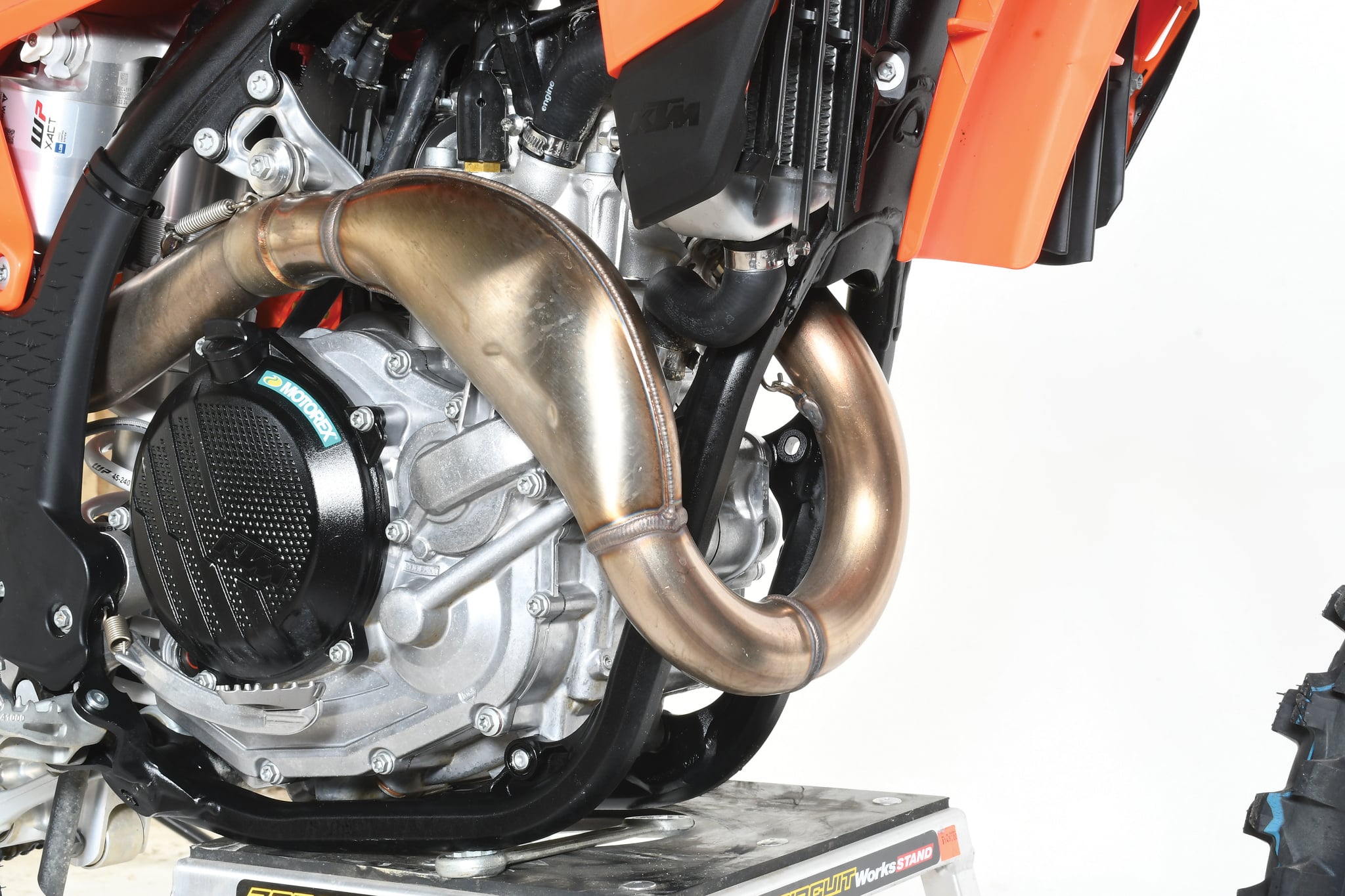 You gotta love the sleek look of KTM’s trademark two-stroke-style resonance chamber.
You gotta love the sleek look of KTM’s trademark two-stroke-style resonance chamber.
Q: HOW DOES THE 2025 KTM 450SXF RUN ON THE TRACK?
A: The engine delivers an amazing style of power. It feels like a tractor from low to mid and a jet fighter from mid to top. It builds power at an unbelievably progressive rate from 5000 rpm to its peak at 9400 rpm. It’s strong on the bottom, stronger in the middle and strongest on top. It makes an impressive 59.20 horsepower at peak.
There is more punch to the 2025 KTM 450SXF. We used to complain that it needed more thrust down low, but now it has it. We think that the new straighter air boot contributes to the power boost.
However, unlike a lot of fast bikes, the KTM remains supremely manageable, whether you are tapped out in fifth or working your way through tight switchbacks in second. “Torquey, broad, powerful and fun” are the watchwords of the 2025 KTM 450SXF. It is a joy to ride, especially in a class where the competition’s engines are either too hard-hitting, barely hitting at all or weak on top. This is the do-it-all engine of the 450 class.
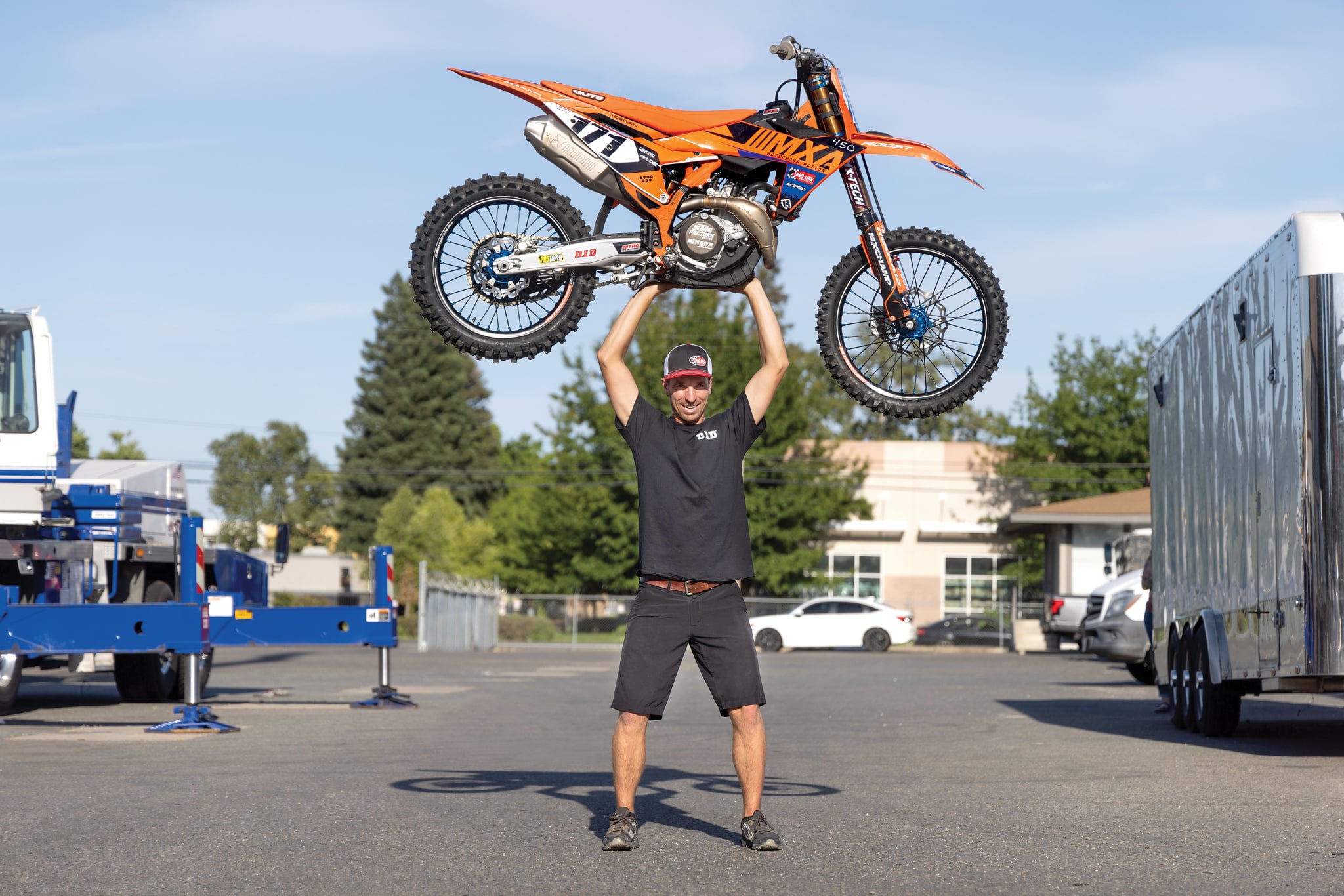 Is the KTM 450SXF that light? Or, is Josh that strong? This was his special Hangtown 450 National bike, but you still need a crane to get it above your head.
Is the KTM 450SXF that light? Or, is Josh that strong? This was his special Hangtown 450 National bike, but you still need a crane to get it above your head.
Q: HOW DOES THE 2025 KTM 450SXF HANDLE?
A: We got a lot of test time on the 2025 KTM 450SXF because we had lots of hours on the 2024-1/2 KTM 450SXF Factory Edition, which is a gussied-up 2025 KTM 450SXF.
The 2022 KTM 450SXF had squat issues, most evident in consecutive whoops, but by rotating the engine backwards, KTM was able to lower the countershaft sprocket by 3mm, which lessened squat under acceleration by reducing chain torque. You can feel the improvement in rear-wheel traction.
As far as the 2024 crop of motocross bikes go as a group, they are all examples of the “give to get” philosophy of frame design. The 2024 Yamaha, Kawasaki, Honda, and Suzuki have all sacrificed stability at speed for the ability to turn tight. The result is bikes that have a tendency to suffer head shake at speed and a touch of over-steer in the corners. These manufacturers focused on cornering prowess at the expense of overall handling. The 2025 KTM 450SXF is the best all-around-handling bike on the track, along with its Austrian stablemates. It is accurate in the corners, laser-guided down the straights, and doesn’t suffer from any chronic tendencies to over-steer in the tight stuff or shake over rough ground.

Q: WHAT DID WE HATE?
A: The hate list:
(1) Start/stop buttons. If you don’t like having the kill button on the right side of the handlebars, Nihilo Concepts and Ride Engineering make separate start and stop buttons that retrofit so you can put the kill button back on the left side.
(2) Finding neutral. Getting the transmission into neutral on the starting line is very hard. It resists being snicked into gear. Our solution is to rev the engine with the clutch pulled in, and when the rpm peaks, we shift into neutral before the rpm drops.
(3) Gas cap. The gas cap sticks—sometimes to the extent that you can’t get it off at the gas station.
 We vastly prefer the old-style radiator cap. This new fangled plastic cap is hard to get to off and hard to turn once you get a grip on it.
We vastly prefer the old-style radiator cap. This new fangled plastic cap is hard to get to off and hard to turn once you get a grip on it.
(4) Radiator cap. The plastic radiator cap is a pain to remove. Nihilo Concepts makes a removal tool to make it easier.
(5) Spokes. KTM’s spokes come loose all the time. If you can’t check all the spokes, be sure to check the spokes closest to the rear rim lock. If those spokes are loose, you need to tighten all the spokes.
(6) Seat height. A massive number of potential KTM racers are disenfranchised by the seat height of the KTM 450SXF. The average height of males in the USA is 5 feet, 9 inches, which means that 50 percent of the male population is over this height and 50 percent is under it. If you are under it, odds are that your feet won’t be able to touch the ground on the starting line.
(7) Shock clicker access. The right-side panel covers up access to the low- and high-speed compression clickers. The best solution is to take a 1-1/4-inch-hole drill bit and cut a circular hole in the side panel to give you access to the clickers.
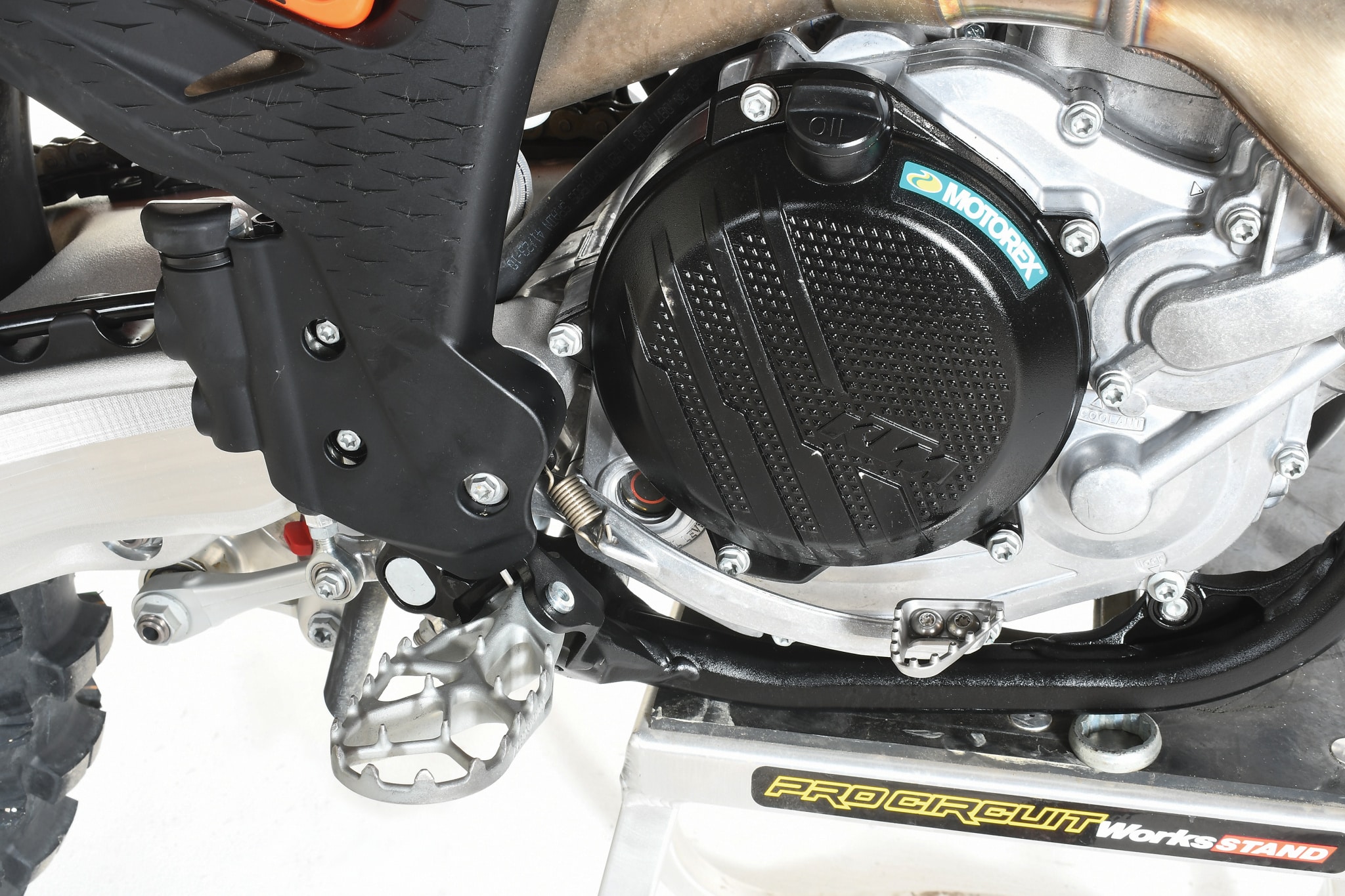 Inside the black clutch cover is KTM’s groundbreaking Belleville washer-activated clutch, which is showing up on more and more Japanese machines.
Inside the black clutch cover is KTM’s groundbreaking Belleville washer-activated clutch, which is showing up on more and more Japanese machines.
Q: WHAT DID WE LIKE?
A: The like list:
(1) Shock collar. WP’s latest shock collar is much easier to use and more durable than it was in the past.
(2) Vented airbox cover. You get two airbox covers when you buy a KTM: a stock cover and an optional vented cover. MXA test riders always prefer the vented cover, except on dusty or wet tracks.
(3) Washing. The giant air vents below the seat are hard to seal off when you pressure-wash your bike. We run Twin Air’s plastic airbox covers to avoid getting water in the engine.
(4) Frame guards. Most MXA test riders like KTM’s fancy frame guards, but we have test riders who remove them because the thickness of the plastic pushes their feet outward (if you remove them, you will be surprised by how much narrower the bike feels at your boots).
(5) No-tools clickers. You can adjust the WP shock and forks without ever using a tool—only the rebound clicker on the shock is hard to get to, but the clicker comes with a slot for a flat-bladed screwdriver.
(6) Maps. The two embedded maps on the left-side switchgear provide two pretty distinct options. Most MXA test riders prefer the white map.
Q: WHAT DO WE REALLY THINK?
A: Did you notice that we never mentioned the electric starter, hydraulic clutch, powerful brakes, indestructible chain guide, no-tools airbox, FIM-legal sound rating, SKF fork seals, quick-release fuel lines, ODI lock-on grips, CNC-billet bell crank, in-mold graphics, marine-grade wiring harness, inline fuel filters, CNC-machined polished hubs and plug-in air-filter cage? If we had, this test would have read like a love letter to the 2025 KTM 450SXF. Well, in a way, it is.







Comments are closed.